How to spot fake emails like "Email Quarantine" scam email
Phishing/ScamAlso Known As: Email Quarantine spam
Get free scan and check if your device is infected.
Remove it nowTo use full-featured product, you have to purchase a license for Combo Cleaner. Seven days free trial available. Combo Cleaner is owned and operated by RCS LT, the parent company of PCRisk.com.
What is the "Email Quarantine" email message?
"Email Quarantine" refers to a phishing spam email campaign. The term "spam campaign" is used to define a mass-scale operation, during which thousands of deceptive emails are sent. The messages distributed through the "Email Quarantine" campaign claim that users have several incoming emails, which have been "quarantined" (i.e., did not reach the inbox).
To prevent these (nonexistent) messages from being deleted, recipients are instructed to log-in to their email accounts. This is the main goal of this scam: to encourage users to inadvertently reveal their email account log-in credentials by entering them into a phishing website.
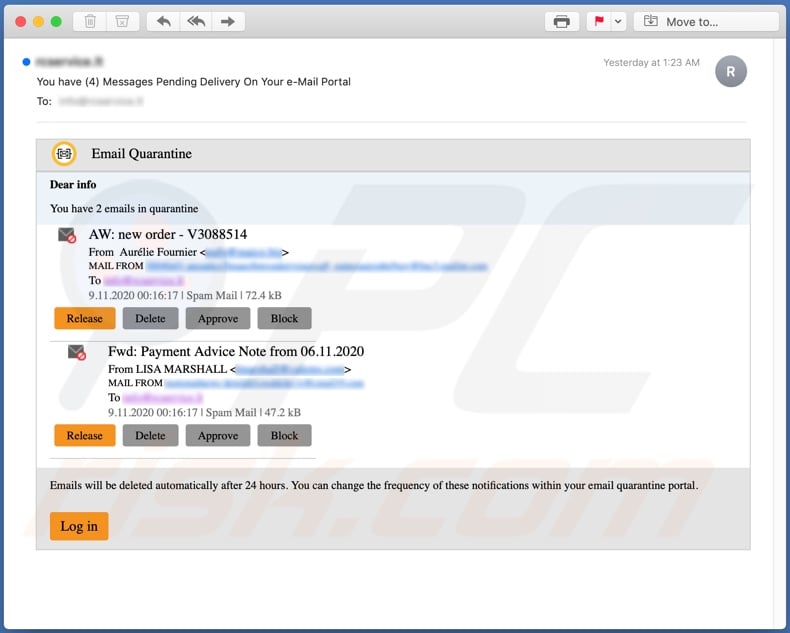
More about the "Email Quarantine" scam email
The "Email Quarantine" messages state that users have a specific number of emails in quarantine (as opposed to in the inbox or specific subfolder in the inbox).
The title/subject of the researched variant was "You have (4) Messages Pending Delivery On Your e-Mail Portal", which implies that there are four "quarantined" emails, however, in the body of the message it is stated that in fact two emails have been held back.
The message is phrased in a way that implies users have a choice of how to approach the fake emails (i.e., release - allow into the inbox, delete, approve or block mail from the sender). To further the sense of urgency, the "Email Quarantine" scam messages claim that the withheld emails will be deleted within 24 hours (implying that users must take action immediately).
The subjects/titles of the nonexistent emails (i.e., "AW: new order - V3088514" and "Fwd: Payment Advice Note from 06.11.2020") are also intended to sound important, thereby increasing users' hastiness. To prevent the imaginary emails from being deleted, users are to click the "Log in" button and re-access their email accounts.
This button redirects to a phishing site, which is disguised as a sign-in/log-in page. The web page states that the session has been terminated and users must sign-in again to continue.
All of the information provided by the "Email Quarantine" emails is false and, by attempting to log-in through the phishing page, users will unintentionally reveal their log-in credentials to the scammers behind this spam campaign. Scammers target email accounts as they are typically connected with other accounts.
Hence, through stolen email accounts, they may gain access to associated ones. Accounts of interest include (but are not limited to) social networking, social media, messaging platform, data storage and sharing, e-commerce, online money transfers, digital wallet, banking, and so on.
To summarize, trusting the "Email Quarantine" scam messages can result in loss of email accounts and others linked with them, serious privacy issues, financial loss and even identity theft. If attempts to sign-in through the phishing website have already been made, you are strongly advised to change the passwords of all potentially compromised accounts.
Additionally, you are advised to contact and inform the official support of all endangered accounts.
| Name | Email Quarantine Email Scam. |
| Threat Type | Phishing, Scam, Social Engineering, Fraud. |
| Fake Claim | Scam emails claim that users have withheld emails and imply that they need to sign-in again to access the messages. |
| Related Domains | z22nv.csb[.]app |
| Serving IP Address (z22nv.csb[.]app) | 104.18.27.114 |
| Symptoms | Unauthorized online purchases, changed online account passwords, identity theft, illegal access of the computer. |
| Distribution methods | Deceptive emails, rogue online pop-up ads, search engine poisoning techniques, misspelled domains. |
| Damage | Loss of sensitive private information, monetary loss, identity theft. |
| Malware Removal (Windows) |
To eliminate possible malware infections, scan your computer with legitimate antivirus software. Our security researchers recommend using Combo Cleaner. Download Combo CleanerTo use full-featured product, you have to purchase a license for Combo Cleaner. 7 days free trial available. Combo Cleaner is owned and operated by RCS LT, the parent company of PCRisk.com. |
Examples of similar scams
"Wire Transfer", "POWERBALL OFFICIAL 2020 WINNINGS", "Your Microsoft subscription has been expired" and "Last Warning: Upgrade your email to avoid Shutting Down" are some examples of other phishing spam campaigns. Phishing schemes do not exclusively target emails, but other accounts and personal information as well.
Spam campaigns can have various purposes and disguises. Furthermore, deceptive emails are also commonly used to proliferate malware (e.g. Trojans, ransomware, cryptominers, etc.). Due to the relative prevalence of scam mail, you are advised to exercise caution with incoming emails.
How do spam campaigns infect computers?
Typically, cyber criminals behind malspam campaigns send emails with a file attached to them or a download link to the malicious file. Their main goal is to trick recipients into opening/executing the rogue file, which then installs malicious software.
Some examples of files that cyber criminals send via email are Microsoft Office and PDF documents, executables (.exe), JavaScript, and archives (ZIP, RAR). Note that malicious documents that are opened with Microsoft Office 2010 or newer versions install malicious software only if users enable macros commands (enable editing/content).
These versions include "Protected View" mode, which does not allow opened malicious documents to install malware automatically. Older versions do not include this feature and install malicious software without asking permission.
How to avoid installation of malware
To avoid malware spread via spam mail, you are strongly advised against opening suspicious or irrelevant emails, especially those with any attachments or links present within them. Additionally, use Microsoft Office versions released after 2010.
Malicious programs are also proliferated through untrusted download channels (e.g. unofficial and free file-hosting sites, Peer-to-Peer sharing networks and other third party downloaders), illegal software activation ("cracking") tools, and fake updaters.
Therefore, only download from official/verified sources and activate and update software with tools/functions provided by legitimate developers. To ensure device integrity and user privacy, have a reputable anti-virus/anti-spyware suite installed and kept updated.
Furthermore, use these programs to run regular system scans and to remove detected/potential threats. If you have already opened malicious attachments, we recommend running a scan with Combo Cleaner Antivirus for Windows to automatically eliminate infiltrated malware.
Text presented in the "Email Quarantine" scam email message:
Subject: You have (4) Messages Pending Delivery On Your e-Mail Portal
Email Quarantine
Dear info
You have 2 emails in quarantine
AW: new order - V3088514
From Aurélie Fournier
MAIL FROM ********
To ********
9.11.2020 00:16:17 | Spam Mail | 72.4 kB
Release
Delete
Approve
Block
Fwd: Payment Advice Note from 06.11.2020
From LISA MARSHALL
MAIL FROM ********
To ********
9.11.2020 00:16:17 | Spam Mail | 47.2 kB
Release
Delete
Approve
Block
Emails will be deleted automatically after 24 hours. You can change the frequency of these notifications within your email quarantine portal.
Log in
Screenshot of the phishing website promoted via "Email Quarantine" scam email:
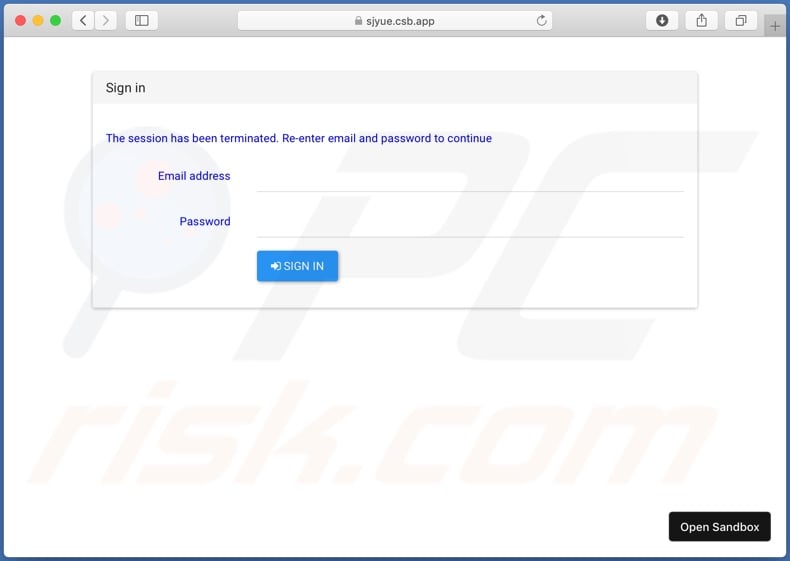
Another email quarantine-themed spam email promoting a phishing website:
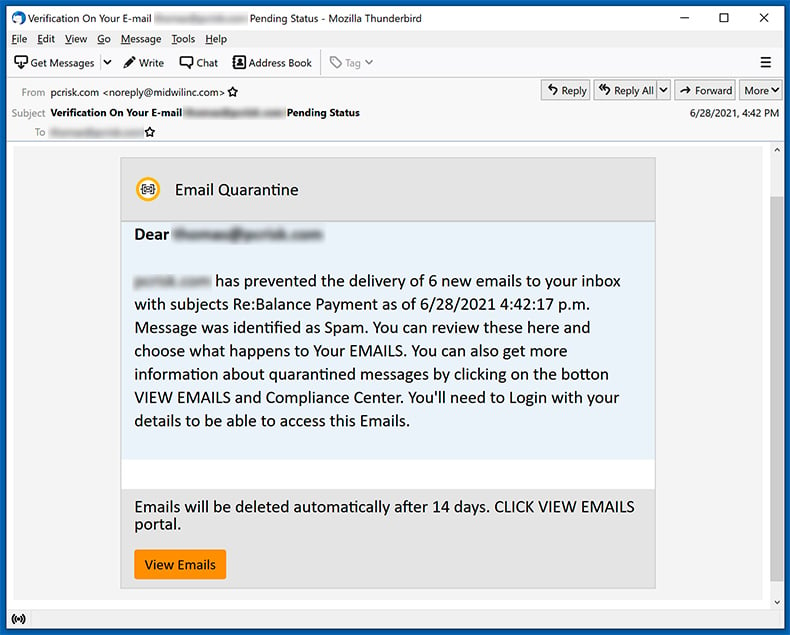
Text presented within:
Subject: Verification On Your E-mail ********* Pending Status
Email Quarantine
Dear ****************** has prevented the delivery of 6 new emails to your inbox with subjects Re:Balance Payment as of 6/28/2021 4:42:17 p.m. Message was identified as Spam. You can review these here and choose what happens to Your EMAILS. You can also get more information about quarantined messages by clicking on the botton VIEW EMAILS and Compliance Center. You'll need to Login with your details to be able to access this Emails.
Emails will be deleted automatically after 14 days. CLICK VIEW EMAILS portal.
View Emails
Appearance of the phishing website promoted via this email:
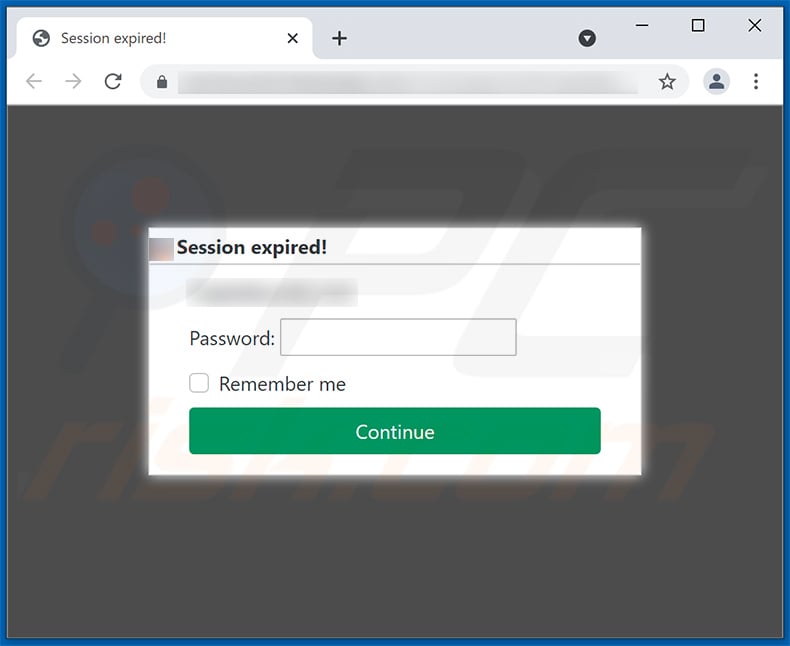
Another example of email quarantine-themed spam:
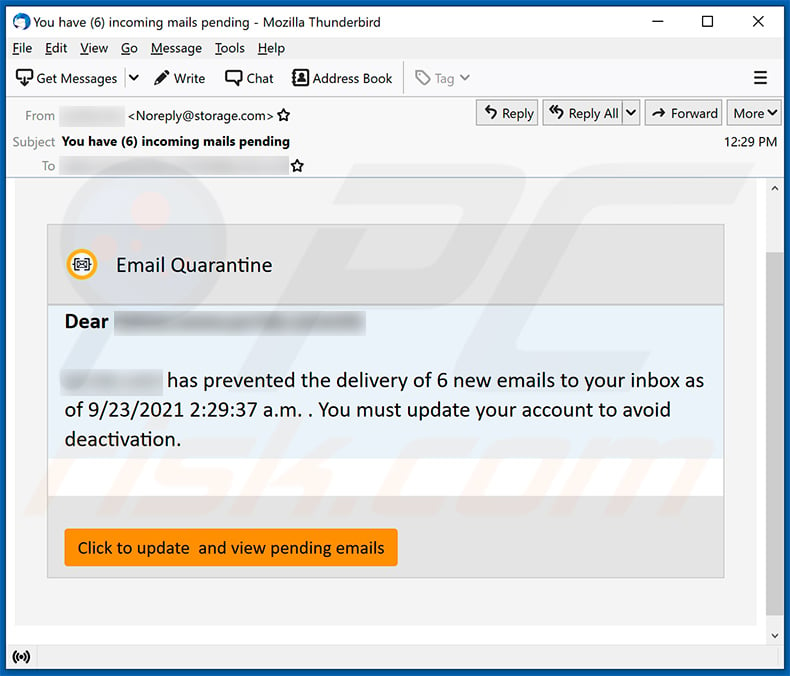
Text presented within:
Subject: You have (6) incoming mails pending
Email Quarantine
Dear -
******** has prevented the delivery of 6 new emails to your inbox as of 9/23/2021 2:29:37 a.m. . You must update your account to avoid deactivation.
Click to update and view pending emails
Another example of email quarantine-themed spam email:
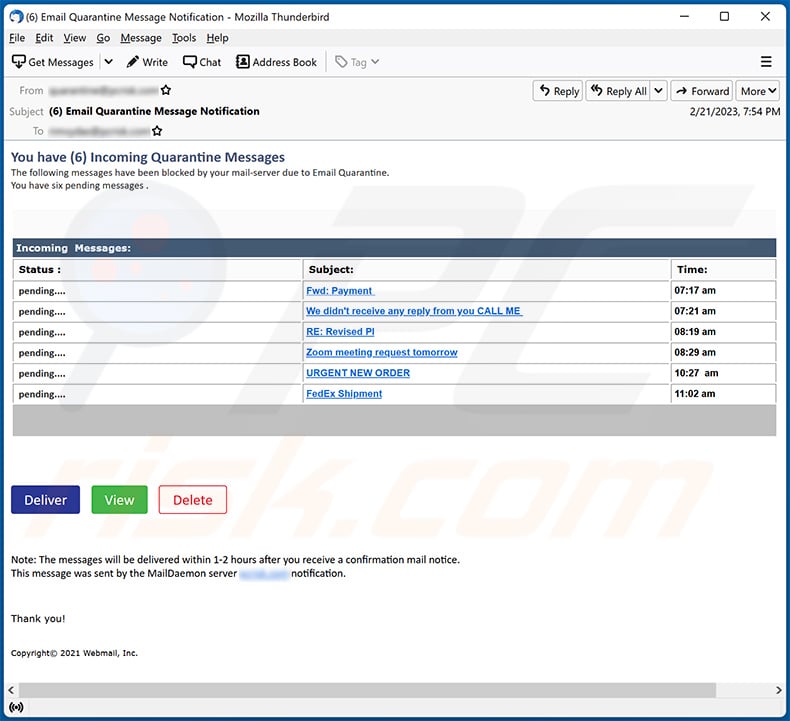
Text presented within:
Subject: (6) Email Quarantine Message Notification
You have (6) Incoming Quarantine Messages
The following messages have been blocked by your mail-server due to Email Quarantine.
You have six pending messages .
Incoming Messages:
Status : Subject: Time:
pending.... Fwd: Payment 07:17 am
pending.... We didn't receive any reply from you CALL ME 07:21 am
pending.... RE: Revised PI 08:19 am
pending.... Zoom meeting request tomorrow 08:29 am
pending.... URGENT NEW ORDER 10:27 am
pending.... FedEx Shipment 11:02 amDeliver View Delete
Note: The messages will be delivered within 1-2 hours after you receive a confirmation mail notice.This message was sent by the MailDaemon server - notification.
Thank you!
Copyright© 2021 Webmail, Inc.
Another example of an email from "Email Quarantine" spam campaign:
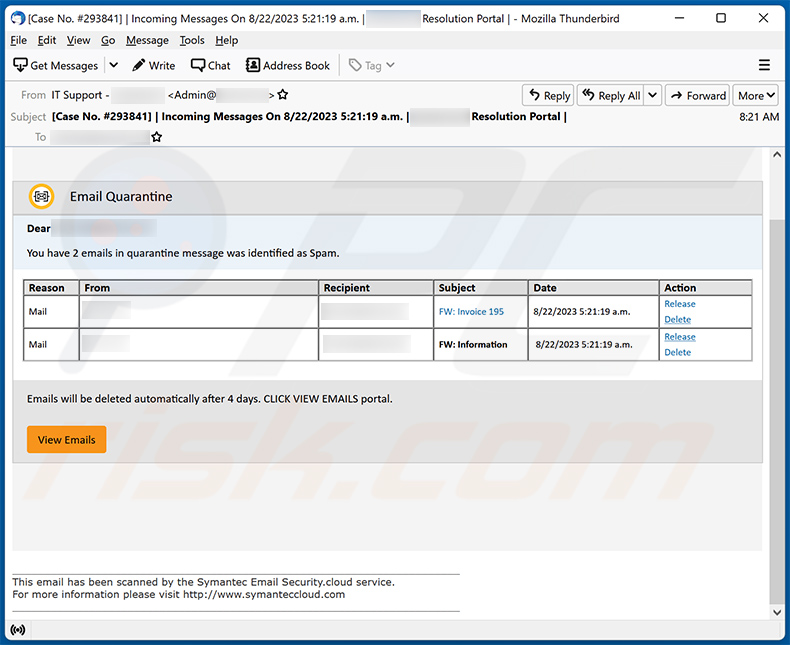
Text presented within:
Subject: [Case No. #293841] | Incoming Messages On 8/22/2023 5:21:19 a.m. | - Resolution Portal |
Email Quarantine
Dear ********
You have 2 emails in quarantine message was identified as Spam.
Reason From Recipient Subject Date Action
Mail - ******** FW: Invoice 195 8/22/2023 5:21:19 a.m. Release Delete
Mail - ******** FW: Information 8/22/2023 5:21:19 a.m. Release DeleteEmails will be deleted automatically after 4 days. CLICK VIEW EMAILS portal.
View Emails
Screenshot of the promoted phishing site:
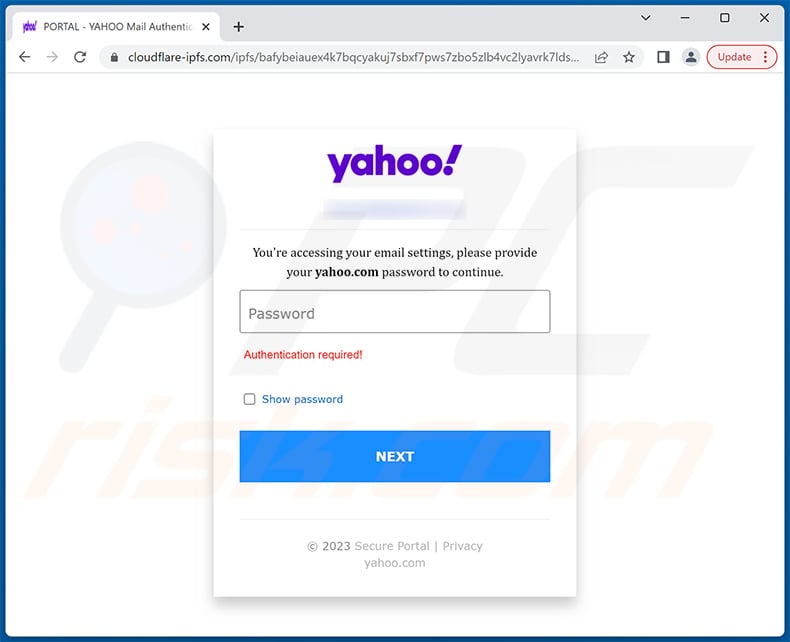
Another example of an email from "Email Quarantine" spam campaign:
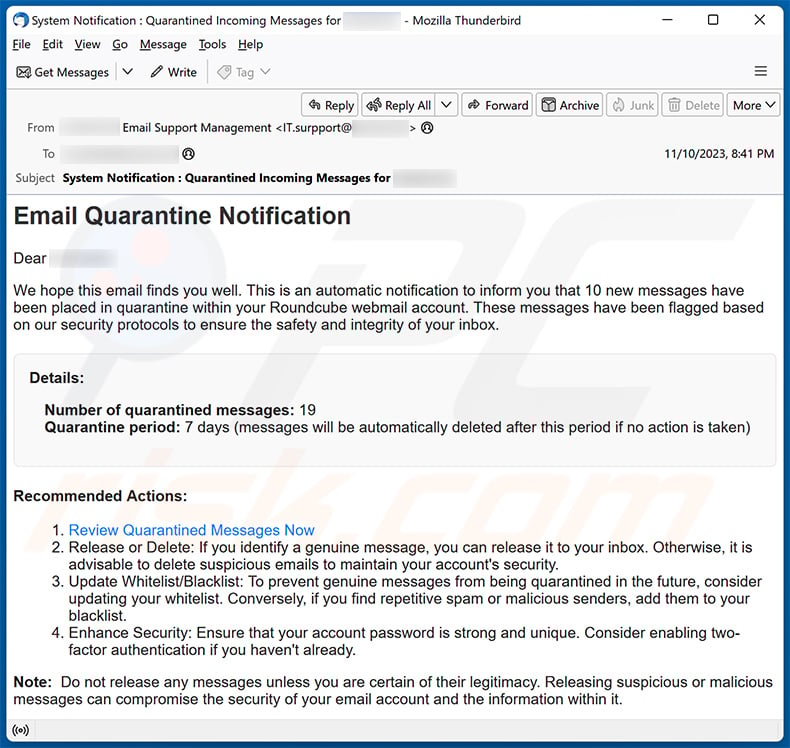
Text presented within:
Subject: System Notification : Quarantined Incoming Messages for -
Email Quarantine NotificationDear -,
We hope this email finds you well. This is an automatic notification to inform you that 10 new messages have been placed in quarantine within your Roundcube webmail account. These messages have been flagged based on our security protocols to ensure the safety and integrity of your inbox.
Details:Number of quarantined messages: 19
Quarantine period: 7 days (messages will be automatically deleted after this period if no action is taken)Recommended Actions:
Review Quarantined Messages Now
Release or Delete: If you identify a genuine message, you can release it to your inbox. Otherwise, it is advisable to delete suspicious emails to maintain your account's security.
Update Whitelist/Blacklist: To prevent genuine messages from being quarantined in the future, consider updating your whitelist. Conversely, if you find repetitive spam or malicious senders, add them to your blacklist.
Enhance Security: Ensure that your account password is strong and unique. Consider enabling two-factor authentication if you haven't already.Note: Do not release any messages unless you are certain of their legitimacy. Releasing suspicious or malicious messages can compromise the security of your email account and the information within it.
Thank you for being vigilant and helping us maintain the security and integrity of our email service.
Warm regards,
Email Server Security
Instant automatic malware removal:
Manual threat removal might be a lengthy and complicated process that requires advanced IT skills. Combo Cleaner is a professional automatic malware removal tool that is recommended to get rid of malware. Download it by clicking the button below:
DOWNLOAD Combo CleanerBy downloading any software listed on this website you agree to our Privacy Policy and Terms of Use. To use full-featured product, you have to purchase a license for Combo Cleaner. 7 days free trial available. Combo Cleaner is owned and operated by RCS LT, the parent company of PCRisk.com.
Quick menu:
- What is Email Quarantine spam?
- Types of malicious emails.
- How to spot a malicious email?
- What to do if you fell for an email scam?
Types of malicious emails:
![]() Phishing Emails
Phishing Emails
Most commonly, cybercriminals use deceptive emails to trick Internet users into giving away their sensitive private information, for example, login information for various online services, email accounts, or online banking information.
Such attacks are called phishing. In a phishing attack, cybercriminals usually send an email message with some popular service logo (for example, Microsoft, DHL, Amazon, Netflix), create urgency (wrong shipping address, expired password, etc.), and place a link which they hope their potential victims will click on.
After clicking the link presented in such email message, victims are redirected to a fake website that looks identical or extremely similar to the original one. Victims are then asked to enter their password, credit card details, or some other information that gets stolen by cybercriminals.
![]() Emails with Malicious Attachments
Emails with Malicious Attachments
Another popular attack vector is email spam with malicious attachments that infect users' computers with malware. Malicious attachments usually carry trojans that are capable of stealing passwords, banking information, and other sensitive information.
In such attacks, cybercriminals' main goal is to trick their potential victims into opening an infected email attachment. To achieve this goal, email messages usually talk about recently received invoices, faxes, or voice messages.
If a potential victim falls for the lure and opens the attachment, their computers get infected, and cybercriminals can collect a lot of sensitive information.
While it's a more complicated method to steal personal information (spam filters and antivirus programs usually detect such attempts), if successful, cybercriminals can get a much wider array of data and can collect information for a long period of time.
![]() Sextortion Emails
Sextortion Emails
This is a type of phishing. In this case, users receive an email claiming that a cybercriminal could access the webcam of the potential victim and has a video recording of one's masturbation.
To get rid of the video, victims are asked to pay a ransom (usually using Bitcoin or another cryptocurrency). Nevertheless, all of these claims are false - users who receive such emails should ignore and delete them.
How to spot a malicious email?
While cyber criminals try to make their lure emails look trustworthy, here are some things that you should look for when trying to spot a phishing email:
- Check the sender's ("from") email address: Hover your mouse over the "from" address and check if it's legitimate. For example, if you received an email from Microsoft, be sure to check if the email address is @microsoft.com and not something suspicious like @m1crosoft.com, @microsfot.com, @account-security-noreply.com, etc.
- Check for generic greetings: If the greeting in the email is "Dear user", "Dear @youremail.com", "Dear valued customer", this should raise suspiciousness. Most commonly, companies call you by your name. Lack of this information could signal a phishing attempt.
- Check the links in the email: Hover your mouse over the link presented in the email, if the link that appears seems suspicious, don't click it. For example, if you received an email from Microsoft and the link in the email shows that it will go to firebasestorage.googleapis.com/v0... you shouldn't trust it. It's best not to click any links in the emails but to visit the company website that sent you the email in the first place.
- Don't blindly trust email attachments: Most commonly, legitimate companies will ask you to log in to their website and to view any documents there; if you received an email with an attachment, it's a good idea to scan it with an antivirus application. Infected email attachments are a common attack vector used by cybercriminals.
To minimise the risk of opening phishing and malicious emails we recommend using Combo Cleaner Antivirus for Windows.
Example of a spam email:

What to do if you fell for an email scam?
- If you clicked on a link in a phishing email and entered your password - be sure to change your password as soon as possible. Usually, cybercriminals collect stolen credentials and then sell them to other groups that use them for malicious purposes. If you change your password in a timely manner, there's a chance that criminals won't have enough time to do any damage.
- If you entered your credit card information - contact your bank as soon as possible and explain the situation. There's a good chance that you will need to cancel your compromised credit card and get a new one.
- If you see any signs of identity theft - you should immediately contact the Federal Trade Commission. This institution will collect information about your situation and create a personal recovery plan.
- If you opened a malicious attachment - your computer is probably infected, you should scan it with a reputable antivirus application. For this purpose, we recommend using Combo Cleaner Antivirus for Windows.
- Help other Internet users - report phishing emails to Anti-Phishing Working Group, FBI’s Internet Crime Complaint Center, National Fraud Information Center and U.S. Department of Justice.
Frequently Asked Questions (FAQ)
Why did I receive this email?
This letter is not addressed to you personally. Scammers behind phishing emails usually send the same letter to all recipients.
I have provided my personal information when tricked by this email, what should I do?
If you opened a phishing page and entered your password, change all your passwords immediately.
I have downloaded and opened a malicious file attached to an email, is my computer infected?
It depends on the type of file that was opened. For instance, executable files usually infect computers right after they are opened. Malicious MS Office documents cannot infect computers until macros commands are enabled.
I have read the email but did not open the attachment, is my computer infected?
Computers get infected via files or links in emails used to distribute malware. Thus, it is safe to open emails without clicking links or opening attachments.
Will Combo Cleaner remove malware infections that were present in email attachment?
Combo Cleaner will scan the operating system and remove detected malware. This app can detect almost all known malware. Since high-end malware usually hides deep in the system, it is required to run a full system scan to remove it.
Share:

Tomas Meskauskas
Expert security researcher, professional malware analyst
I am passionate about computer security and technology. I have an experience of over 10 years working in various companies related to computer technical issue solving and Internet security. I have been working as an author and editor for pcrisk.com since 2010. Follow me on Twitter and LinkedIn to stay informed about the latest online security threats.
PCrisk security portal is brought by a company RCS LT.
Joined forces of security researchers help educate computer users about the latest online security threats. More information about the company RCS LT.
Our malware removal guides are free. However, if you want to support us you can send us a donation.
DonatePCrisk security portal is brought by a company RCS LT.
Joined forces of security researchers help educate computer users about the latest online security threats. More information about the company RCS LT.
Our malware removal guides are free. However, if you want to support us you can send us a donation.
Donate
▼ Show Discussion